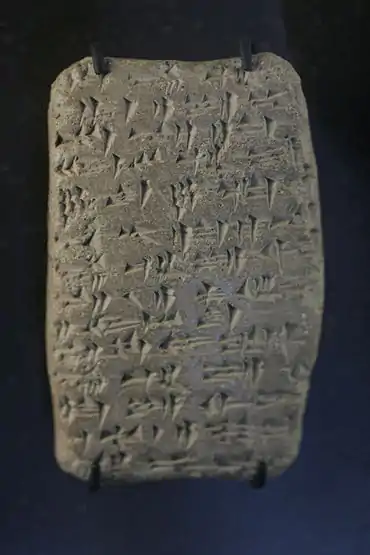Glossenkeil (Amarna letters)
The Glossenkeil (Amarna letters), is a form of the common glossenkeil—𒃵 used in the history of cuneiform texts. It is also named a winkelhaken; however the distinct "U" character in cuneiform–![]() -(for the winkelhaken), has multiple uses (see u (cuneiform)), and winkelhakens are composed of the single "u", or a doubled version, one "u" above a second "u".
-(for the winkelhaken), has multiple uses (see u (cuneiform)), and winkelhakens are composed of the single "u", or a doubled version, one "u" above a second "u".

(very high-resolution expandable photo)
| Wikimedia Commons has media related to Glossenkeil (Amarna letters). |
The glossenkeil (Amarna letters)–![]() is a fore shortened version of the vertical diš (cuneiform)–
is a fore shortened version of the vertical diš (cuneiform)–![]() , and is inscribed at a 45 degree angle.
, and is inscribed at a 45 degree angle.
Because the scribe's stylus is being used at an angle, (almost any corner of a stylus end could be used); if a scribe had two styli, of differing sizes, and both ends shaped for inscribing, that automatically implies at least four types of stylus tip impressions that could be made (from the two, double-ended styli). As an example of the stroke of a stylus, the Jerusalem scribe, in EA 287, has created a 4–stroke ri (cuneiform) sign from the 5–stroke, "ri" sign, by sweeping the left horizontal stroke, as the beginning of 2 strokes, and finishing the sweep of the stylus at the small angled intermediate stroke; (the Jerusalem scribe's stroke could easily be started in reverse order).
See also
References
- Moran, William L. The Amarna Letters. Johns Hopkins University Press, 1987, 1992. (softcover, ISBN 0-8018-6715-0)